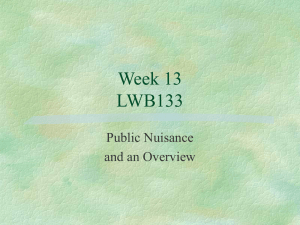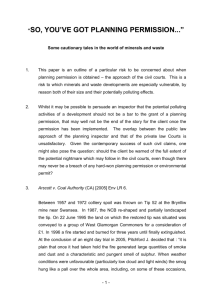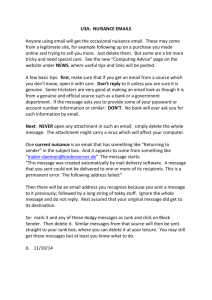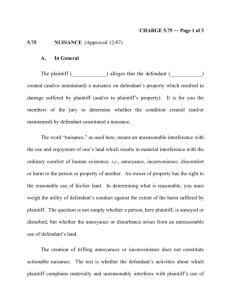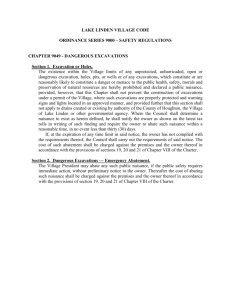Nuisance - City University of Hong Kong
advertisement
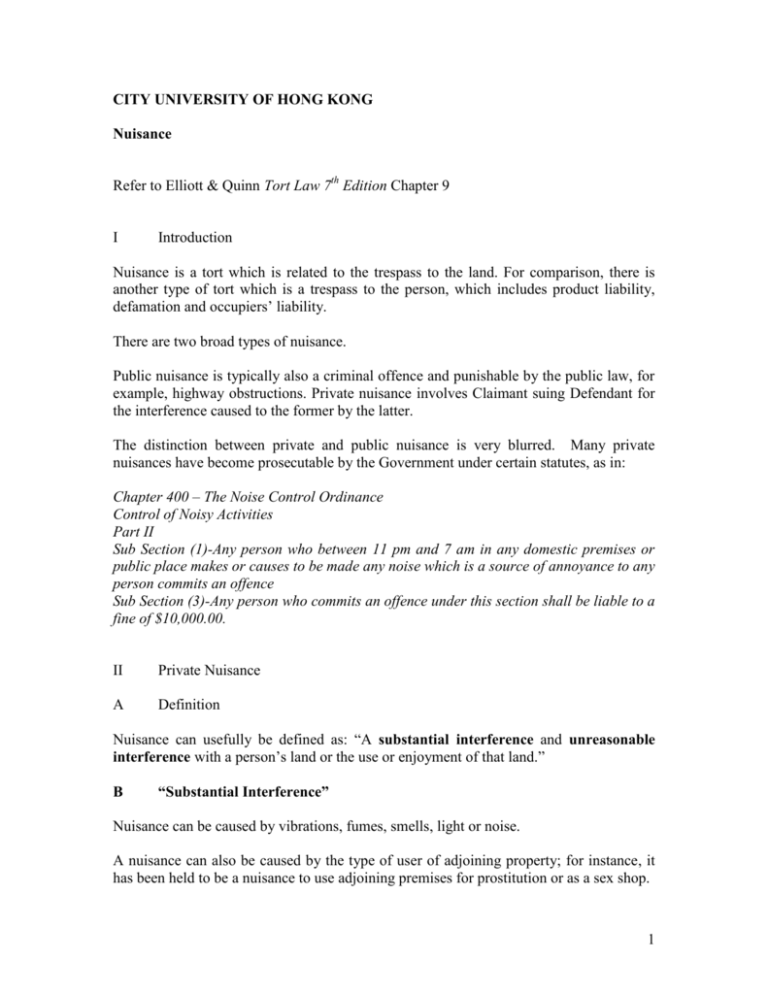
CITY UNIVERSITY OF HONG KONG Nuisance Refer to Elliott & Quinn Tort Law 7th Edition Chapter 9 I Introduction Nuisance is a tort which is related to the trespass to the land. For comparison, there is another type of tort which is a trespass to the person, which includes product liability, defamation and occupiers’ liability. There are two broad types of nuisance. Public nuisance is typically also a criminal offence and punishable by the public law, for example, highway obstructions. Private nuisance involves Claimant suing Defendant for the interference caused to the former by the latter. The distinction between private and public nuisance is very blurred. Many private nuisances have become prosecutable by the Government under certain statutes, as in: Chapter 400 – The Noise Control Ordinance Control of Noisy Activities Part II Sub Section (1)-Any person who between 11 pm and 7 am in any domestic premises or public place makes or causes to be made any noise which is a source of annoyance to any person commits an offence Sub Section (3)-Any person who commits an offence under this section shall be liable to a fine of $10,000.00. II Private Nuisance A Definition Nuisance can usefully be defined as: “A substantial interference and unreasonable interference with a person’s land or the use or enjoyment of that land.” B “Substantial Interference” Nuisance can be caused by vibrations, fumes, smells, light or noise. A nuisance can also be caused by the type of user of adjoining property; for instance, it has been held to be a nuisance to use adjoining premises for prostitution or as a sex shop. 1 To be actionable, a nuisance must be substantial. In assessing what is substantial, a range of factors are considered. B1 Amenity (enjoyment) Nuisance In cases where the complaint is an interference with the use or enjoyment of land, several factors are relevant to gauging the “substantial” nature of the nuisance. (a) Unusual Sensitivity of Claimant The factor may be taken into account in deciding whether to impose legal liability. The concept is that if you have a thin skull, you should protect yourself well. Robinson v Kilvert [1889] 41 Ch D 88 (b) Location of Claimant’s Premises What is a nuisance in one locality may not be a nuisance in another. Sturges v Bridgman [1879] 11 Ch D 852 B2 Material Damage to Land Cases in this category don’t relate to use or enjoyment of the land but focus on matters like flooding, collapses of Defendant’s buildings onto Claimant’s buildings and the like. St. Helens Smelting Co v Tipping [1865] 11 HL 642 C “Unreasonable Interference” Several factors can again be identified that help to determine unreasonableness. C1 Seriousness of the Interference The more serious an interference, the easier it can be classified as unreasonable. (a) Duration The longer an interference, the more serious it is. And the more serious, the more unreasonable it is. Matania v National Provincial Bank [1936] 2 All ER 633 (b) Extent of the Harm 2 In the St Helen’s case, Lord Wensleydale stated: The Law does not regard trifling and small inconveniences, but only regards sensible inconveniences which sensibly diminish the comfort… of the property affected. LORD WENSLEYDALE: My Lords, I entirely agree in opinion with both my noble and learned friends in this case. …where great works have been created and carried on, and are the means of developing the national wealth, you must not stand on extreme rights and allow a person to say, 'I will bring an action against you' for this and that and so on. Business could not go on if that were so. Everything must be looked at from a reasonable point of view; therefore, the law does not regard trifling and small inconveniences, but only regards sensible inconveniences - injuries which sensibly diminish the comfort, enjoyment, or value of the property which is affected." I do not think that the question could have been more correctly laid down by any one to the jury, and I entirely concur in the propriety of dismissing this appeal. (c) Character of the Harm It is generally more difficult to justify physical damage to Claimant’s land than amenity nuisance. C2 Reasonableness of Defendant’s User There are several factors that affect the reasonableness of Defendant’s user. (a) Defendant’s motives / purposes for acting The more unreasonable Defendant’s user, the harder to justify the interference it causes. This in no way affects the strictness of the liability. Hollywood Silver Fox v Emmett [1936] 2 KB 468 Note: In Hunter, Lord Cooke said, “The malicious (evil-minded) erection of a structure for the purpose of interfering with TV reception should be actionable in nuisance.” (b) (c) Fault on Defendant’s Part; and The Practicability of Avoiding an Interference. If Defendant simply has taken steps to avoid his activities from causing disturbance, the fact that he does not take those steps may be taken by the courts to support a finding that Defendant was engaged in an unreasonable user. Leeman v Montagu [1936] 2 All ER 1677 3 III Who Can Sue? Nuisance is a tort against land, one needs a real property interest in order to sue. Hunter v Canary Wharf [1997] 2 All ER 426 “An action in private nuisance will only lie at the suit of a person who has a right to the land affected… a mere licensee on the land has no right to sue.” [per Lord Goff] IV Who Can be Sued? A Creators of the Nuisance It is well accepted that whoever creates the nuisance may be held liable in respect of it. Thus the creator may always be liable. Thompson v Gibson [1841] The defendants erected a building which excluded the public from a part of a space on which a market was lawfully held. The site of the building was owned, not by the defendants, but by the local corporation, and the defendants could not have removed the building except by committing a trespass against the corporation. After the building had been erected, the owner of the market demised the market to the plaintiff. Held: notwithstanding their inability to remove the building, the defendants, as the original wrongdoers, were liable to the plaintiff for continuing the nuisance. B Occupiers B1 Adopting and Continuing Nuisances Created by Another One adopts a nuisance when one makes use of the state of affairs comprising the nuisance. One continues a nuisance where one fails to abate nuisance where one has actual or constructive knowledge of the nuisance. Sedleigh-Denfield v O’Callaghan [1940] AC 880 B2 Adopting or Continuing Nuisances Created by Nature The above principle applies to cases of nuisances created by nature. Leakey v National Trust [1980] QB 485 B3 Occupier has Control over the Creator 4 Where Defendant has sufficient control over the creator of the nuisance, for example, where he calls in independent contractors who create a dangerous state of affairs – the occupier can be held liable. Matania v National Provincial Bank [1936] 2 All ER 633 C Lessors Leasing a property ends the lessor’s potential for liability. The basis of this rule is that the lessor has relinquished control over the property in such circumstances. But there are exceptions. C1 Nuisance Expressly or Impliedly Authorised by Lessor Where a lessor grants the tenancy in the actual or constructive knowledge that the land will be used for a nuisance-creating purpose he may be said to authorize it. Tetley v Chitty [1986] 1 All ER 663 C2 Duty to Repair Expressly or Reservedly Retained Where a lessor has retained the right to do repairs, he will be responsible for any nuisance emanating from the poor state of repairs. Wringe v Cohen [1939] V Defences Several defences, both partial and absolute exist to an action framed on the basis of private nuisance. 1 Prescription (for over 12 years) The idea here is that if one uses land in a particular way for 12 years without complaint, then one acquires what is called a prescriptive right to continue to use it in that way. Refer to CAP 347 Limitation Ordinance s.4; and Sturges v Bridgman [1879] 11 Ch D 852 2 Statutory authority – by statute. If a defendant is authorized by statute to do a thing, then the defendant is immune from suit for any disturbance caused. 5 Allen v Gulf Oil Refining Ltd [1981] AC 1001 3 Acts of God/Strangers Force Majeure (Acts of God) – inevitable accidents of nature (or nuisances created by third parties) which are neither adopted nor continued by the defendant will not support an action in nuisance against the defendant. 4 Other defences, like necessity. VI Remedies Nuisance law supports two main remedies: damages and injunctions. As regards the damages, the idea is to pay to Claimant the difference between the value of the interest before and after the nuisance. But losses are only recoverable to the extent that there was an unlawful interference. Andreae v Selfridge & Co [1938] Ch 1 Injunctions, by contrast, are a discretionary (not a must, up to the judge to decide) remedy and are the remedy most often sought because they require to stop his interference generating process. Wheeler v JJ Saunders Ltd [1995] 2 All ER 697 Related Cases Robinson v Kilvert [1889] The Claimant occupied the ground floor of the Defendant’s premises, using it to store brown paper. The Defendant’s business involved making paper boxes which was carried on in the basement of the same building. It needed a dry, hot atmosphere. The heating used by the Defendant in the cellar made the Claimant’s floor hot too, which dried out the brown paper, reducing its value. The Claimant sued in nuisance, but the court found that brown paper was exceptionally delicate. As the heat was not sufficient to damage paper generally and it had not inconvenienced the Claimant’s workmen, the damage was due more to the sensitivity of the paper than to the defendant’s activities, so there was no nuisance. Hunter v Canary Wharf [1997] The Claimants were people living in the area near the huge tower known as Canary Wharf, which was causing interference with their television reception. The Court of 6 Appeal decided that loss of this kind of recreational facility was not sufficient interference to give rise to an action in nuisance. St Helens Smelting Co v Tipping Ltd [1865] Fumes from a copper-smelting works actually damaged trees and shrubs which are grown on the Claimant’s neighboring land. The claimant’s estate was situated in an industrial area, and in deciding whether the fumes from the copper works amounted to nuisance, the House of Lords distinguished between nuisances causing actual injury to property, as in this case, and nuisances causing personal discomfort. In the latter case, claimants should be prepared to put up with the level of discomfort common to the area in which they are situated. However, Claimants were not expected to tolerate actual damage to their land resulting from the normal activities of the locality, and so an injunction was granted. Sturges v Bridgman [1879] The Claimant was a doctor, who sued a confectioner for the noise caused by his industrial equipment. The court took into account the fact that the area in which they both worked consisted mainly of doctors’ consulting rooms and concluded that there was a nuisance, explaining that that which would be a nuisance in a quiet residential area would not necessarily be so in a busy industrialized one. Hollywood Silver Fox Farm Ltd v Emmett [1936] The Claimant bred foxes on his land. The Defendant was a neighbour and after a disagreement with the Claimant, told his son to shoot his gun in he air which standing close to the Claimant’s land in order to frighten the vixens so that they undergo a miscarriage and would not breed. The Claimant’s action succeeded, for while the Defendant was entitled to go shooting for the purposes of hunting game, his malicious motive rendered his activity an unreasonable interference with his neighbour’s enjoyment of his land. Leakey v National Trust [1980] The Defendant’s occupied land on which there was a large, naturally occurring mound known as Barrow Mump. After one very hot summer, they were aware that the area could be affected by landslides, due to the earth drying out, but they took no precautions against this. A landslide did occur, casting earth and tree roots onto neighbouring land, and the defendants refused to remove the debris. The Courts held that they were liable for the nuisance, even though they had not actually done anything to cause it, but had merely failed to prevent it. Christie v Davey [1893] 1 Ch 316 The Claimant, a music teacher, held musical parties in his house. The Defendant, his next-door neighbor, deliberately tried to disturb both lessons and parties by blowing whistles, banging trays, shrieking and hammering on the wall. The Court held that this malicious motive made the Defendant’s conduct unreasonable and a nuisance. Had he not been trying to disturb the lessons, he might have had the right to make a noise, just as the Claimant did with his lessons and parties. 7 Wheeler v J J Saunders Ltd [1995] The Defendants had obtained planning permission to build two pig houses close to the Claimant’s land, resulting in strong smells drifting across the Claimant’s property. The Court of Appeal confirmed that planning permission could only be taken as authorization of nuisance if its effect was to alter the character of the neighbourhood so that the nuisance could not be considered unreasonable. The planning permission in this case did not have that effect. Allen v Gulf Oil Refining Ltd [1981] Residents in the area where the Defendant were operating an oil refinery brought an action claiming that the refinery was causing nuisance. The company pleaded in their defense that the nuisance was an inevitable result of operating the refinery, which they had power under statute to do. The relevant Act only gave express permission to the company to compulsorily purchase land and to build the refinery but did not expressly give them power to operate it. However, the Courts said that it must have been Parliament’s intention that they should also operate the refinery, so such a power could be inferred. Dr Eric Cheng City University of Hong Kong 13 March 2015 8

